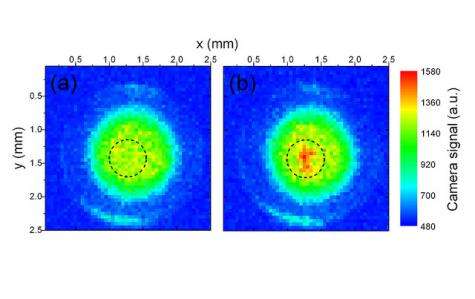Argonne researchers find new isotope for climatological dating

(PhysOrg.com) -- Radioactive dating is used to determine everything from the age of dinosaur fossils to Native American arrowheads. A new technique recently developed at the U.S. Department of Energy's Argonne National Laboratory may give researchers another tool for radioactive dating that could be of particular use in studying the history of climate change.
Argonne physicist Peter Mueller and his colleagues created a special "atom trap" to isolate and study argon-39, an exceptionally rare isotope of a noble gas that occurs naturally in small quantities in the atmosphere.
According to Mueller, most atmospheric argon is argon-40, which means it contains 18 protons and 22 neutrons. However, occasionally an incoming high-energy proton from outer space — also known as a cosmic ray — collides with the nucleus of an argon-40 atom to kick out one neutron and create an unstable, radioactive isotope.
This process happens so infrequently that radioactive argon-39 is present in the atmosphere in only extremely minute quantities: less than one argon-39 atom per one quadrillion atoms of argon-40 (one quadrillion equals 1,000,000,000,000,000).
"Even deciding to study this exotic isotope raised a number of different challenges," Mueller said. "When we have so little of our target atom to work with naturally, we have to make sure that we're counting as many as possible of them out of the samples we have while not making any mistakes in sorting them out."
The advantage of using argon-39 for radioactive dating lies in its unique half-life, which is approximately 270 years. "Some well-established radio dating isotopes, like carbon-14, have half-lives of several millennia, while others, like tritium or krypton-85, have half-lives on the range of only years to decades," Mueller said. "Argon-39, even though it is exceptionally rare, is really a kind of Goldilocks isotope for some uses. Its half-life is not too short, not too long — it's just right."
According to Mueller, scientists studying the dynamics of groundwater or ocean currents on the timescale of 100 to 1,000 years might find argon-39 dating to be a particularly useful tool in their analysis. "The good news for people who want to study things like groundwater flows or ocean mixing," he said, "is that we have a pretty good understanding of how argon behaves in these environments. Argon-39 is almost an ideal clock for these purposes."
To isolate argon-39 atoms from argon gas, Mueller and his colleagues built a device called an atom trap. The atom trap uses six laser beams to form a "cage" that catches only argon-39 while letting through all atoms of argon-40 or any other isotopes present in the sample. Once trapped, an argon-39 atom appears as a bright dot on a sensitive video camera.
"Argon-39 is so rare that we have to measure and detect the atoms one at a time," said Robert Janssens, director of Argonne's Physics Division. "It is an involved and painstaking process."
A lot of the experimental research involved looking at an empty trap, Mueller explained: "Every few hours, we'd detect the signatures from just a handful of individual atoms. Because we're looking for something so rare, we need to be both patient and precise in order to find it."
Provided by Argonne National Laboratory


















